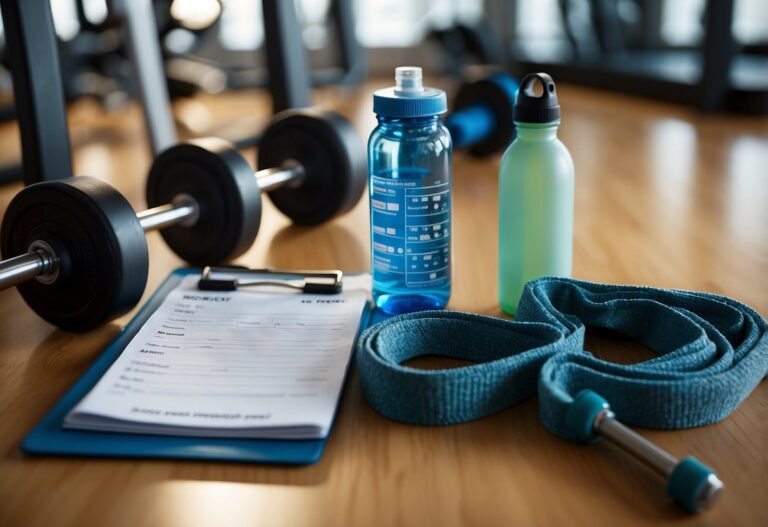Getting back into exercise after having a baby might seem challenging, but it’s an important step towards regaining your strength and energy. You might feel overwhelmed with new responsibilities and changes in your body, but finding a workout plan that suits your needs can make a world of difference. Starting a postpartum workout routine can help you feel stronger and more energised amidst the demands of new motherhood.

It’s normal to have many questions about which exercises are safe and effective after childbirth. You might wonder how to start, what to avoid, and how to manage your time. Balancing your health with your new role is crucial and achievable with the right approach. With some helpful tips, you can confidently begin your postpartum fitness journey and find the routine that works best for you.
Strengthen your core with pelvic tilts
To help rebuild your core strength after giving birth, pelvic tilts are a great exercise.
Start by getting on your hands and knees, keeping your back straight.
Tilt your pelvis forward by tucking your tailbone under. Hold this position for a few seconds.
Then, tilt your pelvis back by rounding your back. Repeat this movement 10 times.
Doing pelvic tilts regularly can help improve your posture and strengthen your pelvic floor muscles. You might find it easier to include these in your routine right before bedtime.
Engage in Kegel exercises for pelvic floor
Starting Kegel exercises after giving birth is important for strengthening your pelvic floor. These exercises help regain muscle tone and control, which can be especially beneficial after childbirth.
To do Kegels, first find your pelvic floor muscles. A simple way is to try stopping the flow of urine mid-stream.
Once you locate them, tighten these muscles for about five seconds, then relax for five seconds.
Repeat this 10 times in one session. Aim for three sessions daily.
You can do Kegels almost anywhere – sitting at your desk, watching TV, or even while nursing your baby. They don’t require any special equipment or a lot of time.
Check out more on performing Kegels at Kegel8.
Regular practice can aid in recovery, giving you better control and confidence.
Practice Bridges to Tone Glutes
Practising bridges is a great way to tone your glutes, especially during the postpartum period. This exercise can help you regain strength in your lower body.
Start by lying on your back with your knees bent and feet flat on the floor. Your feet should be hip-width apart.
Press through your heels to lift your hips towards the ceiling. Ensure you squeeze your glutes tightly at the top.
Hold the position for a second, then lower your hips back down. Repeat this movement for several reps.
Using your breath to stabilise your core can make a big difference. Inhale as you lower your hips and exhale as you lift them.
Adding a weight, like a dumbbell or weighted plate, can increase intensity. Place the weight across your hips and perform the movement as usual. This can help strengthen your glutes even more.
These tips should make your bridge practice more effective. For a more detailed guide on glute bridges, check out Laura Jawad’s blog post.
Incorporate Walking into Your Routine
Walking is a great way to start your postpartum fitness journey. It’s low-impact, which means it’s gentle on your body as it heals. Plus, you can easily fit it into your daily routine.
You might begin with short, 10-minute walks around your neighbourhood. Over time, you can gradually increase the duration and intensity.
Make it enjoyable by listening to your favourite music or podcast. You can even bring the stroller and enjoy a walk with your baby.
Consistency is key. Try to walk at the same time each day. This helps create a habit and keeps you motivated.
Utilise light dumbbells for arm workouts

Using light dumbbells can make a big difference in your postpartum arm workouts. Start with bent-over dumbbell rows. Hold a dumbbell in each hand and bend over slightly. Keep your back straight and lift the weights until your arms are just below shoulder height. This can help strengthen your arms and back.
Try shoulder raises by lifting one arm straight in front and then over your head. Do this for 30 seconds. This easy move can tone your shoulders and upper arms.
Give the cross body shoulder stretch a go. Bring one arm across your chest and use your opposite hand to pull it closer. Hold for 10-15 seconds, then switch sides. This stretch feels great and helps keep your muscles flexible.
With light dumbbell exercises, you can slowly build up strength without overdoing it. Remember, consistency is key. These workouts fit easily into a busy schedule and can be done at home, making them perfect for new mums.
Try yoga stretches for flexibility
Yoga stretches can help you regain flexibility after childbirth. These stretches are gentle on your body and can ease tension built up during pregnancy. For example, stretching your back and legs can feel really good.
Cat-Cow stretch is great for your spine. Start on your hands and knees, arch your back like a cat, and then dip it like a cow.
Child’s Pose can relax your back. Sit back on your heels and stretch your arms forward on the floor.
Holding these poses for a few breaths can improve flexibility over time. If you feel any pain, stop right away.
Include Squats to Build Leg Strength
Squats are one of the best exercises to include in your postpartum workout. They help build leg strength and improve stability. By focusing on your quads, hamstrings, and glutes, squats provide a solid foundation for your overall fitness.
Start by standing with your feet hip-width apart. Lower yourself as if sitting in a chair. Keep your back straight and knees behind your toes. Return to standing. Aim for three sets of twelve reps.
If squats feel too easy, try holding your baby for added resistance. Always listen to your body and adjust the intensity based on your comfort level.
Do gentle abdominal exercises
Starting with pelvic tilts can help. Lie on your back with your knees bent. Tighten your abdominal muscles and flatten your lower back against the floor. Hold, then release.
Heel slides are another excellent choice. Lie on your back with your knees bent. Slide one heel away from your body while keeping your core engaged. Return to start and switch sides.
Try side-lying abdominal contractions. Lie on your side with knees slightly bent. Tighten your core and hold the contraction briefly before relaxing. Repeat a few times on each side. These exercises can gently strengthen your core after giving birth.
Join a Postpartum Exercise Class
Joining a postpartum exercise class can be a game-changer for new mums. It’s a great way to rebuild your strength and connect with others in the same phase of life.
Many classes focus on exercises that help with core strength and pelvic floor health. These areas are crucial for recovery after childbirth.
You also get to meet other new mums, which can be incredibly supportive. Sharing experiences and tips with others who understand your journey can make a big difference.
Consider looking for local classes or online options like Pvolve, which offers low-impact workouts designed specifically for postpartum health.
Use a Resistance Band for Strength Training
Using a resistance band for strength training can be great for your postpartum workout. Resistance bands are gentle on your joints, which is essential during this delicate time. You can start with simple exercises to work on different muscle groups at home.
For instance, you can try a postnatal strength workout that targets your hips, glutes, and core. Stand with your feet hip-width apart, tighten your abs, and tuck your pelvis upwards.
Another helpful exercise is pressing the band overhead, which can strengthen your shoulders and arms. Stand on the band, grab the other end, and press it up till your elbows are locked out.
Taking things slow and steady is key. Have you tried using a resistance band for your at-home workouts yet? If not, it might be a good time to start!
Benefits of Postpartum Workouts
Postpartum workouts offer numerous advantages for new mums. From boosting physical health to enhancing mental well-being, they play a vital role in recovery and overall quality of life.
Physical Health
Regular postpartum exercise can help you regain physical strength and endurance. Activities such as walking, gentle stretching, and specific postpartum exercises like Kegels or basic core workouts can speed up recovery after childbirth. These exercises improve cardiovascular health, helping you maintain a healthy weight and reducing the risk of heart disease.
Strengthening exercises, like bird dogs, are beneficial for rebuilding muscles affected by pregnancy. They target the core, back, and glutes, which are crucial in supporting your daily activities and reducing postpartum aches and pains. Consistent workouts can also help manage post-pregnancy weight gain by boosting your metabolism and burning extra calories.
Mental Well-being
Exercise has a significant impact on mental health during the postpartum period. Physical activity releases endorphins, which enhance your mood and provide a natural boost of energy. This can be particularly helpful in combating postpartum depression and anxiety, common challenges for many new mums.
Engaging in a postpartum workout routine can also improve sleep patterns. Better sleep contributes to your overall mental health by helping you feel more rested and less stressed. Making time for regular exercise serves as a self-care practice, giving you a break from daily responsibilities and reducing feelings of overwhelm. This break is vital for maintaining mental clarity and emotional balance during this demanding phase of life.
Timing Your Postpartum Exercise

Your postpartum recovery is crucial for both you and your baby’s health. It’s important to know when to start exercising and to consult your healthcare provider to ensure you’re on the right track.
When To Start
The timing of starting your postpartum exercise can vary. Many experts recommend beginning with light activities, such as Kegel exercises and walking, within the first 24 hours after birth, as long as you feel up to it. Even if you had a C-section or a complicated birth, gentle movements can boost your recovery. Aim for several short walks throughout the day, which can total around 30 minutes. These activities help improve blood circulation and promote healing.
Wait about six weeks before considering more intense exercises like running or weightlifting. This gives your body enough time to heal, especially if you’ve had stitches or surgery. Once you reach 12 weeks postpartum, gradually build up your endurance. Starting too soon can lead to injuries or complications, so patience is key.
Consulting Your Healthcare Provider
Before jumping into a fitness routine, always consult with your healthcare provider. They can assess your physical condition and provide personalised advice. It’s especially important if you experienced complications during childbirth. Your provider might suggest specific exercises that are safe and effective for your situation.
Discussing with a professional ensures that you aren’t over-exerting yourself. They can guide you on how to recognise your body’s signals and when to take it easy. Your healthcare provider can also recommend resources or suggest a physical therapist specialising in postpartum recovery, ensuring you get the right support.
Types Of Postpartum Exercises
Postpartum exercises help enhance your physical recovery, improve your health, and boost your mood. They include low-impact cardio, strength training, and pelvic floor exercises.
Low-Impact Cardio
Low-impact cardio includes activities like walking and swimming, which are gentle on your joints. Experts recommend starting with short walks as soon as you’re comfortable, even within the first 24 hours post-birth. Walking can be broken into several five-minute sessions throughout the day to make it easier.
Swimming is another excellent option because it provides a full-body workout while supporting your body weight in the water. This reduces strain on your body while helping to improve cardiovascular health. Always ensure the water is clean and consider waiting until any bleeding has fully stopped to avoid infections.
Strength Training
Strength training focuses on rebuilding muscle strength, especially in your core, back, and legs. You can start with lightweight exercises like bodyweight squats, modified push-ups, and resistance band workouts.
Simple exercises like squats help rebuild leg strength, while bird dogs can strengthen your core and improve balance. Bird dogs, done on your hands and knees, involve extending one arm and the opposite leg simultaneously while keeping your back straight. This exercise particularly targets the lower back, abdominals, and buttocks.
Pelvic Floor Exercises
Pelvic floor exercises are crucial for postpartum recovery as they strengthen the muscles that support your bladder, bowel, and uterus. Kegel exercises are the most commonly recommended for this purpose. They involve contracting and relaxing the pelvic floor muscles, mimicking the action of stopping the flow of urine.
You can do Kegels almost anywhere and anytime, starting as soon as you feel ready after birth. They help reduce the risk of incontinence and improve pelvic floor function, which is essential for overall recovery. Remember to focus on technique, aiming to hold each contraction for a few seconds before releasing. Always consult your doctor before starting any new exercise routine.
Safety Tips For Postpartum Workouts
Listen to Your Body
Your body has been through a lot. Pay attention to how you feel during and after workouts. If something doesn’t feel right, it probably isn’t. It’s okay to take it slow.
Example: If you feel pain in your abdomen during a core exercise, stop and rest.
Start Slow and Build Gradually
Begin with light activities like walking or gentle stretching. Gradually increase intensity as your strength returns. Avoid jumping back into high-intensity workouts right away.
Incorporate Kegel Exercises
Kegels help strengthen your pelvic floor, which is crucial after giving birth. You can start these exercises within the first 24 hours post-birth if you feel comfortable.
Warm-Up and Cool Down
Always include a warm-up and cool-down in your routine. Warming up prepares your muscles, while cooling down helps your body recover.
Stay Hydrated
Drink plenty of water before, during, and after your workout. Hydration is key to maintaining energy and avoiding cramps.
Wear Supportive Gear
Invest in a good sports bra and supportive shoes. Proper gear can prevent injury and make your workout more comfortable.
Avoid High-Impact Exercises Initially
Focus on low-impact activities like walking or yoga. High-impact exercises like running can be tough on your body initially.
Know When to Seek Help
If you experience heavy bleeding, severe pain, or other warning signs, contact your healthcare provider. It’s important to ensure your body is healing properly.
Example Postpartum Workout Routine
| Exercise | Duration | Notes |
|---|---|---|
| Walking | 10-30 min | Start with short walks |
| Kegels | 5 min | Do multiple times a day |
| Gentle Yoga | 15-20 min | Focus on breathing and light stretching |
| Pelvic Tilts | 5 min | Helps strengthen the core |
Helpful Websites
Prioritising safety ensures you can enjoy your workouts and gradually rebuild your strength. Your journey back to fitness is unique, so be kind to yourself and celebrate each milestone.







